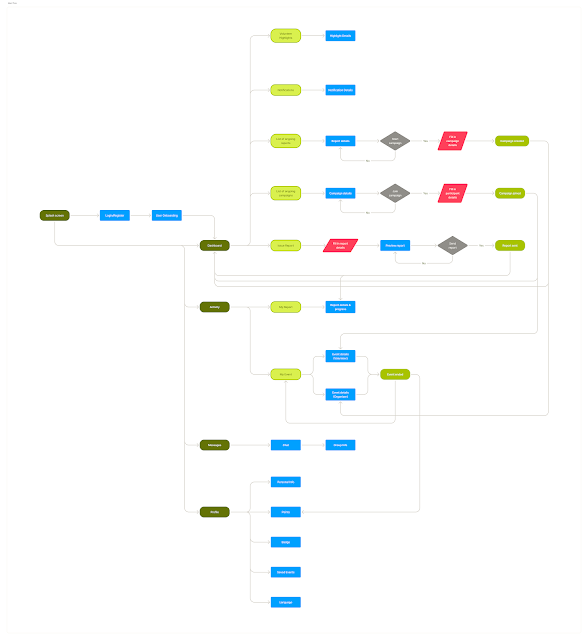Major Project
23.04.2024 - 11.08.2024 (Week 1 - Week 16)
Lulu Luisa Linardi / 0349358 / Bachelor of Design (Hons) in Creative Media
Major Project
Final Year Project
 |
| Fig 1.0: Thumbnail |
INSTRUCTIONS
Week 1
I personally have one idea in mind to propose, which is a platform that focuses on helping individuals discover great recipes and plan their daily meals while also maintaining a healthy diet. This idea originated from another subject in a previous semester but wasn’t selected for execution, so I decided to refine it for this project.
Week 2
During my first consultation with Mr. Razif, it seemed like he didn’t fully grasp my idea and recommended that I outline it on a Miro board, breaking it down into key problems.
Week 3
I refined my key propositions and added a few more key activities. However, Mr. Razif still wasn’t fully on board with the idea. He advised me to explore a new concept to compare with my current one, so we could determine which is better.
Week 4
Mr. Razif also added few ideas for my app, here's the list of his suggestions:
• The platform should involve local authorities to ensure that the collected rubbish is disposed of properly in designated areas.
• Organizers could have a button that generates a standardized email template for the volunteer event, based on the information provided.
• With a single click, the email or notice can be sent to local authorities, and the app will display the approval status.
• Additional Feature: Once approved, the app can provide details on what the authorities will contribute, such as rubbish disposal services or even manpower.
Furthermore, he also suggested to create this kind of user flow:
• The general public reports an issue, takes pictures, and posts it in the app.
• A volunteer is needed to organize the cleanup event.
• The app includes a button for users to volunteer as an organizer.
• If no one has volunteered yet, a button will appear to lead the campaign.
• Once someone volunteers to lead, the lead button disappears, indicating that the campaign is now active and has a designated status. As for the campaign status, there will be:
1. Waiting/Pending for Leader: Indicates that a leader is still needed.
2. Pending for Partners/Organizers: Shows that partners or organizers are required.
3. Active: Once an organizer is confirmed, the button changes from “Organize” to “Join” to allow others to participate.
As there will be organizer and volunteer participant, there will be a slight different flow for both.
For Organizers:
- Once someone volunteers to organize, they need to plan the event’s flow, considering all the necessary coordination and tasks.
For Participants:
- Participants need to understand their responsibilities once they join the event.
- Although there are separate flows for organizers and volunteers during the planning process, both groups will ultimately see the same official event agenda page.
- Organizers are responsible not only for coordinating volunteers but also for planning the event’s agenda.
Week 5
Here is the link to the survey results:
https://docs.google.com/spreadsheets/d/15ALFMmFNbEu8Z-KAYLAnohVYw0tJfWS-pClgKWzNOz8/edit?usp=sharing
I also developed three user personas.
And finally, I decided on the name "Tangan Bersama" for my app.
Week 6
Week 7
This week, I focused on creating low-fidelity prototypes for some of the main screens, including the Home screen, Report Details, Event Creation, Event Details, List of Participating Events, and Message-Chats. These initial sketches helped me establish the basic layout and functionality for each screen, laying the base for the more detailed designs to come.
I showed this to Mr. Razif during the consultation, and he told me I can proceed to high fidelity prototype already.
Week 8 - 10
Week 11
This week, I began designing the app's icon, focusing on creating a logo that represents the platform’s purpose and values. I created four different design versions since I’m still unsure which one will be finalized.
In addition to the logo, I worked on mockups for the app showcase as well. I also created key visuals for the presentation board, which will be used during the final showcase to highlight the app’s unique aspects.
Here's the link to my final key visuals:
https://drive.google.com/drive/folders/11ZQvzKMA8I23R385L2LgAC2exswBirDC?usp=sharing
Alongside these tasks, I started designing the low-fidelity microsite, which will serve as a promotional site for the app. The microsite is planned to include three pages: a landing page, a features page, and an about us page.
Week 12
Week 13 - 14
With the feedback I received, I focused on refining everything as quickly as possible to ensure I still had time to complete the remaining screens. My goal was to get back on track and finalize the designs without compromising quality. I experimented with gradients to make the design look more polished. I applied different gradient styles in several screens to see which ones worked best. Below is the preview of me playing with the gradient.
As for the app icon, I decided to use this as the final one.
Week 15
From the user testing, I gathered all the feedbacks and concluded these.
I also created collateral materials, such as promotional posters, sticker packs, social media ads, and billboard ads, to promote the app.
Week 16
FINAL SUBMISSION
Here's the Google Drive link for all the assets:
https://drive.google.com/drive/folders/1tKjf0SxDi8WAauS5tRqe7AcUJ7Y4seS2?usp=drive_link
• Mobile App
• Microsite
Looking back on this project, I’m proud of the progress I made each week, from empathize to user testing, coming out with ideas to refining ideas, wireframing to finalizing the app design. The feedback I received along the way helped me improve my work and stay on track. Participating in the final year showcase was indeed a memorable experience, allowing me to present my project to the public and receive valuable input from all the visitors. This journey has been challenging, but it has also been an invaluable learning experience that has strengthened my skills as a designer. Thank you Taylor's for the unforgettable three years!





.png)

.png)
.png)






























